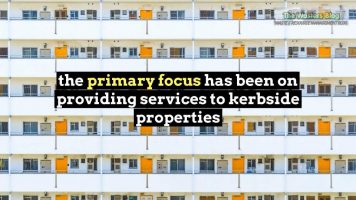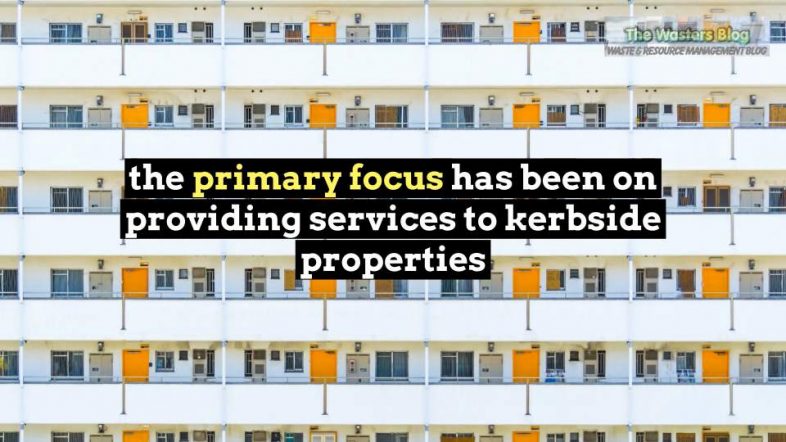Increasing Recycling Collection in Flats (Apartment Buildings) is the next big recycling challenge for cities. “Recycling Is Easy… Unless You Live In A Flat”, Agnieszka Chruszcz wrote recently in the CIWM Journal about Flats Recycling (Apartment Recycling).
 As a senior consultant at Resource Futures, engaged work on improving recycling collection in flats, Agnieszka says:
As a senior consultant at Resource Futures, engaged work on improving recycling collection in flats, Agnieszka says:
“Recycling in flats has been overlooked, and we can’t ignore the challenges that householders and local authorities are facing in increasing recycling from these homes…”
Agnieszka is working on the following project for Resource London*, known as the flats recycling project (it could equally have been called the apartments recycling project) and its all-about better recycling collection in flats:
Flats Recycling Project (Apartment Recycling)
The Flats Recycling Project is a programme of work focused on improving recycling collection in flats. More precisely, in purpose-built flats. It that will run until March 2020.
Now watch our video for a QUICK OVERVIEW of the topic. Don’t forget to come back here afterwards and scroll on down through this page, for more information on the parallel experiences of New York, that ultimate in high-rise city dwelling.
The project will concentrate on increasing recycling in existing flats, as well as explore how sustainable waste management solutions can be designed into all new build flats.
On average, flat dwellers recycle half as much as those who live in houses.
With purpose-built flats making up 37% of London’s residential accommodation, encouraging greater household recycling by flat dwellers is key to increasing the capital’s recycling rate. With the number of people living in flats increasing (nearly all new build properties in London are purpose-built flats and by 2030 nearly half (46%) of London households will be purpose-built flats). It means that finding solutions that deliver higher recycling participation by flat dwellers will be critical to delivering the Mayor’s recycling target.
In the last few weeks it’s been great seeing more discussion on recycling collection in flats and apartments. Throughout my time in the waste management industry flats have been overlooked, as the primary focus has been on providing services to kerbside properties and increasing recycling from these types of households.
However as 88% of new build properties in London are flats, and the percentage of people in London living in flats is likely to rise to almost 50% by 2030, we can’t ignore the challenges that householders and local authorities are facing in increasing recycling from these homes.
“…I will never again say that recycling is easy. It is easy unless you live in a flat.”
Fire hazards, chutes and dropped kerbs are also incredibly important to know about, if any changes or improvements are to be made to the service provision safely. …
Over the last few months, we’ve been doing this type of work as part of the baseline for the research that has recently been launched by Resource London to understand the barriers to recycling in these types of properties and to trial innovative and disruptive solutions.
Throughout this research it struck me how much residents are actually asked to do to recycle. In many situations they need to walk down several flights of stairs. This is often to the back of the block, nowhere near their usual route out. And, it’s often dark during the winter months and in the evenings.
Even if they make this effort they are sometimes faced with a less than pleasant bin store.
Compare that to the kerbside resident experience where waste and recycling is picked up from the front of their house, the containers are often free to replace if they get broken. And, for kerbside recyclers the information on how to use the services is plentiful.
This experience has given her a new level of understanding and sympathy for these residents. Sympathy should also be given to those who try to do the right thing. She says that she will never again say that recycling is easy.
It is easy unless you live in a flat or apartment. via Flats Recycling Project
* Resource London is a newly created partnership programme formed by LWARB and WRAP, the government’s resource efficiency body. The new programme supports London boroughs to deliver more consistent and efficient waste and recycling services for London.
When we read this we thought about the ultimate high rise city of New York, and as we anticipated we found that they not only have the same problems but they have already written about their own strategies to achieve apartment recycling (recycling for people who live in flats), as in the following excerpt:
Increasing Recycling Collection in Flats/ US Flats Recycling: Challenges of Increasing Apartment Recycling in NYC
Limited Space
Buildings looking to increase apartment recycling with these voluntary programs must find adequate space, ideally located near existing blue and green bins and those for regular trash.
Popular spots seem to be basements and laundry rooms, but not all buildings are lucky enough to have such extra space.
Moreover, success brings its own challenges since whatever extra space exists is often taken up by the storage of (bulky) mixed plastic, glass, metal, and paper recyclables which are now picked up just once weekly (compared to twice or thrice weekly trash pickups).
Getting Commitment from Boards, Property Managers, and Supers to Help Increase Recycling in Multi-family Apartment Buildings
Superintendents seem to be the gatekeeper for these voluntary in-building apartment recycling programs since they are responsible for trash management and building maintenance.
Scepticism is an issue for increasing recycling collection in flats. Building officials ask:
“Will residents actually participate in these programs, or will I be doing extra work with little or no results? What if the clothing, electronics, and especially organics are not collected in a timely fashion, as promised, within five to seven business days?”
Not surprisingly, collection of organics raises particular concerns about odours, and food scraps becoming a magnet for flies and rodents.
Increasing Recycling Collection in Flats Through Educating Apartment Dwellers
Enthusiasm for and alignment with existing blue and green bin apartment recycling collection programs can be a gauge of potential receptivity for these new voluntary programs.
Co-locating bins in well-trafficked spaces helps create awareness, but time and resources still need to be allotted to providing specifics about what to drop in the bins and what to direct to the trash, all to minimise ‘aspirational recycling‘.
Time can also be consumed in picking up after residents who drop non-recyclables into the bins. via wehatetowaste.com






Us flat dwellers do care about nature and the environment. But, do recognise that we don’t drive into town using vast amounts of gas just to go to work. We just walk to work or get on a bus So, give us a break and stop suggesting it really matters if we don’t recycle. It generally goes to the incinerator anyway.